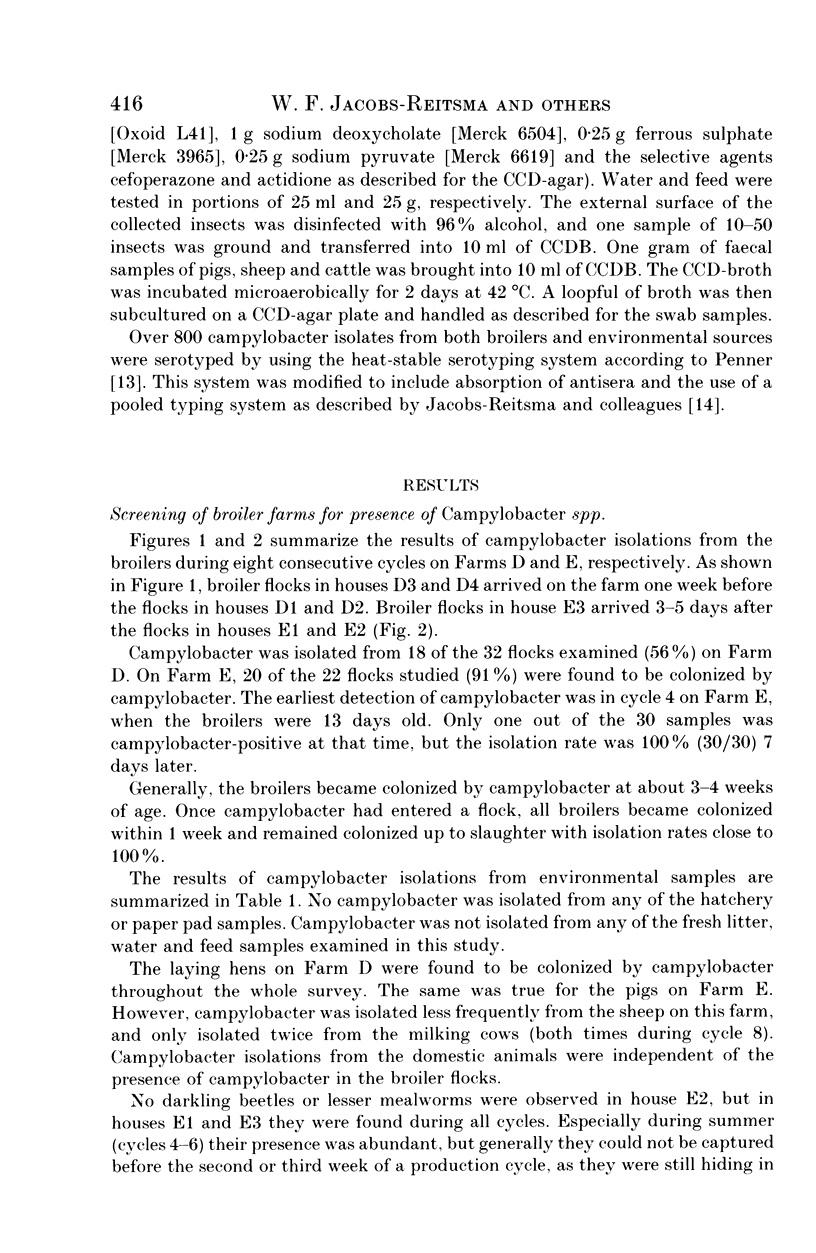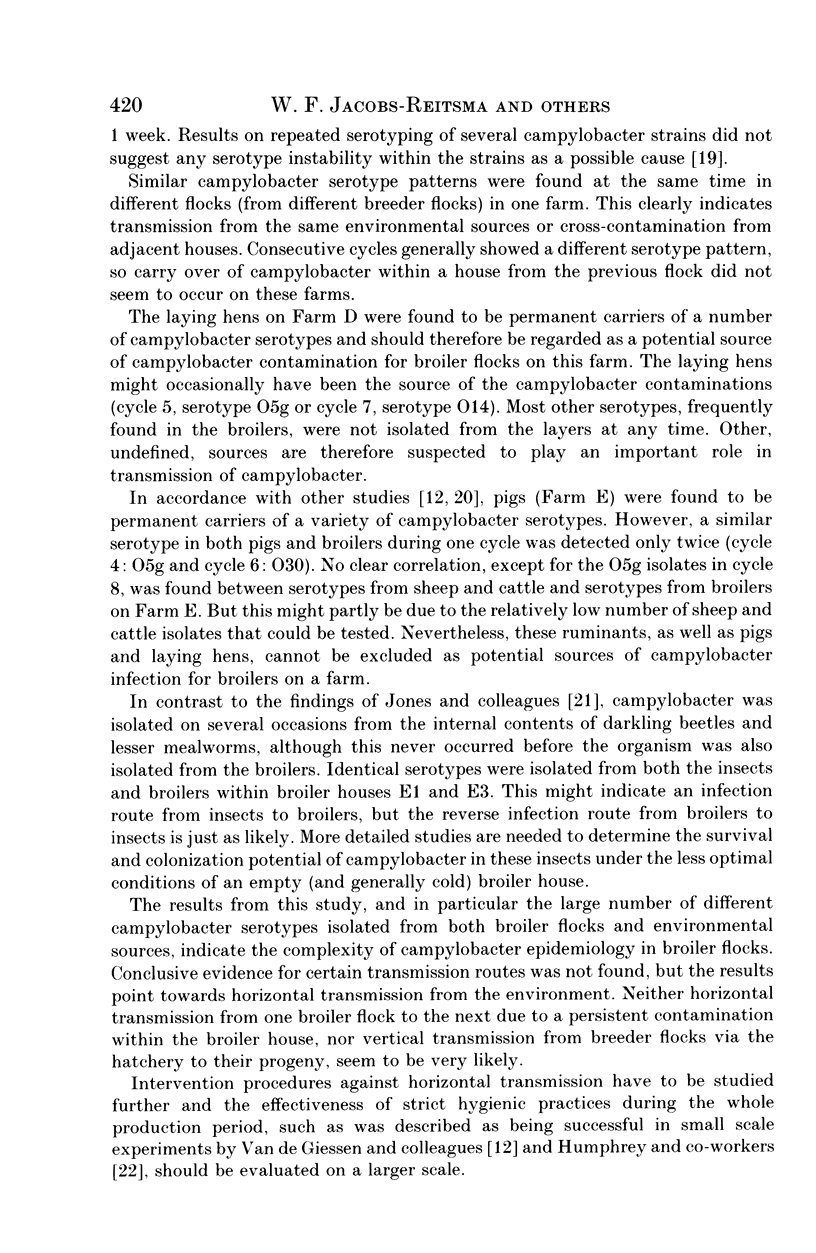Abstract
Broiler flocks on two Dutch poultry farms were screened weekly for the presence of campylobacter in fresh caecal droppings during eight consecutive production cycles. Hatchery and fresh litter samples were taken at the start of each new cycle. Water, feed, insects, and faeces of domestic animals, present on the farms were also included in the sampling. Penner serotyping of isolates was used to identify epidemiological factors that contribute to campylobacter colonization in the broiler flocks. Generally, broiler flocks became colonized with campylobacter at about 3-4 weeks of age with isolation percentages of 100%, and stayed colonized up to slaughter. A similar pattern of serotypes was found within the various broiler houses on one farm during one production cycle. New flocks generally showed also a new pattern of serotypes. Most serotypes isolated from the laying hens, pigs, sheep and cattle were different from those isolated from the broilers at the same time. Campylobacter serotypes from darkling beetles inside the broiler houses were identical to the ones isolated from the broilers. No campylobacter was isolated from any of the hatchery, water, feed or fresh litter samples. Conclusive evidence of transmission routes was not found, but results certainly point towards horizontal transmission from the environment. Horizontal transmission from one broiler flock to the next one via a persistent contamination within the broiler house, as well as vertical transmission from breeder flocks via the hatchery to progeny, did not seem to be very likely.
Full text
PDF








Selected References
These references are in PubMed. This may not be the complete list of references from this article.
- Altmeyer M., Krabisch P., Dorn P. Zum Vorkommen und zur Verbreitung von Campylobacter jejuni/coli in der Jungmastgeflügel-Produktion. 1. Mitteilung. Dtsch Tierarztl Wochenschr. 1985 Nov 26;92(11-12):456–459. [PubMed] [Google Scholar]
- Annan-Prah A., Janc M. The mode of spread of Campylobacter jejuni/coli to broiler flocks. Zentralbl Veterinarmed B. 1988 Jan;35(1):11–18. doi: 10.1111/j.1439-0450.1988.tb00461.x. [DOI] [PubMed] [Google Scholar]
- Blaser M. J., Taylor D. N., Feldman R. A. Epidemiology of Campylobacter jejuni infections. Epidemiol Rev. 1983;5:157–176. doi: 10.1093/oxfordjournals.epirev.a036256. [DOI] [PubMed] [Google Scholar]
- Christenson B., Ringner A., Blücher C., Billaudelle H., Gundtoft K. N., Eriksson G., Böttiger M. An outbreak of campylobacter enteritis among the staff of a poultry abattoir in Sweden. Scand J Infect Dis. 1983;15(2):167–172. doi: 10.3109/inf.1983.15.issue-2.07. [DOI] [PubMed] [Google Scholar]
- Engvall A., Bergqvist A., Sandstedt K., Danielsson-Tham M. L. Colonization of broilers with Campylobacter in conventional broiler-chicken flocks. Acta Vet Scand. 1986;27(4):540–547. doi: 10.1186/BF03548133. [DOI] [PMC free article] [PubMed] [Google Scholar]
- Evans S. J. Introduction and spread of thermophilic campylobacters in broiler flocks. Vet Rec. 1992 Dec 19;131(25-26):574–576. [PubMed] [Google Scholar]
- Humphrey T. J., Henley A., Lanning D. G. The colonization of broiler chickens with Campylobacter jejuni: some epidemiological investigations. Epidemiol Infect. 1993 Jun;110(3):601–607. doi: 10.1017/s0950268800051025. [DOI] [PMC free article] [PubMed] [Google Scholar]
- Jones D. M., Robinson D. A. Occupatonal exposure to Campylobacter jejuni infection. Lancet. 1981 Feb 21;1(8217):440–441. doi: 10.1016/s0140-6736(81)91818-3. [DOI] [PubMed] [Google Scholar]
- Penner J. L., Hennessy J. N. Passive hemagglutination technique for serotyping Campylobacter fetus subsp. jejuni on the basis of soluble heat-stable antigens. J Clin Microbiol. 1980 Dec;12(6):732–737. doi: 10.1128/jcm.12.6.732-737.1980. [DOI] [PMC free article] [PubMed] [Google Scholar]
- Shanker S., Lee A., Sorrell T. C. Campylobacter jejuni in broilers: the role of vertical transmission. J Hyg (Lond) 1986 Apr;96(2):153–159. doi: 10.1017/s002217240006592x. [DOI] [PMC free article] [PubMed] [Google Scholar]
- Sjögren E., Kaijser B. Serotyping studies of Campylobacter from naturally colonized chickens. Epidemiol Infect. 1989 Apr;102(2):215–219. doi: 10.1017/s0950268800029885. [DOI] [PMC free article] [PubMed] [Google Scholar]
- Skirrow M. B. Epidemiology of Campylobacter enteritis. Int J Food Microbiol. 1991 Jan;12(1):9–16. doi: 10.1016/0168-1605(91)90044-p. [DOI] [PubMed] [Google Scholar]
- Weijtens M. J., Bijker P. G., Van der Plas J., Urlings H. A., Biesheuvel M. H. Prevalence of campylobacter in pigs during fattening; an epidemiological study. Vet Q. 1993 Dec;15(4):138–143. doi: 10.1080/01652176.1993.9694392. [DOI] [PubMed] [Google Scholar]
- van de Giessen A., Mazurier S. I., Jacobs-Reitsma W., Jansen W., Berkers P., Ritmeester W., Wernars K. Study on the epidemiology and control of Campylobacter jejuni in poultry broiler flocks. Appl Environ Microbiol. 1992 Jun;58(6):1913–1917. doi: 10.1128/aem.58.6.1913-1917.1992. [DOI] [PMC free article] [PubMed] [Google Scholar]


